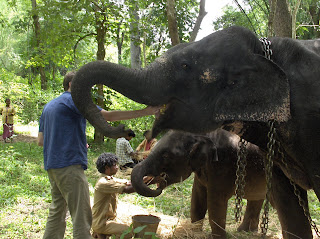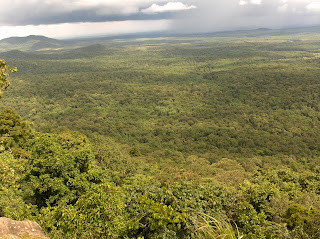It’s now my fifth day in Mysore and I am starting to feel acclimated to the environment as well as the time zone (12.5 hours ahead of San Francisco). I must admit that my trip had a rough start. After traveling for 26 hours, Stephanie and I arrived at Bangalore airport around 1 am local time. We claimed our luggage and then headed towards the airport exit. One of my bags had been marked with chalk, which meant that it was going to be search by customs. The bag they selected was full of clothes as well as a conference telephone. When they asked if I had electronics in my bag I decided not to lie, I thought the conference telephone would not be a major problem. A customs agent pulled out the telephone and told me that I would need to pay tax on the phone. He asked if I had a receipt or knew how much the phone cost. I said no and guessed that the phone cost around $50 (it really didn’t look very fancy!). The customs agent went to his computer, searched, and told me that the phone costs $900 and I owed $360 in tax! Panic!
I looked at the website and told him that the phone I was transporting had fewer features than the one he had found, and he agreed that I was transporting the $600 model, but I still owed $240. I told him I was not carrying that much money and I would need to go to an ATM. I walked out of customs to an ATM, where Stephanie had now been waiting for quite a while. I withdrew money and took a paper from Stephanie that contained information on PHRI. When I got back to the customs agent I tried to explain that I was coming to volunteer with a nonprofit and that I did not have a receipt because the conference telephone was donated. After talking for a while, he asked if I needed a receipt from him. I told him no. Then he told me to follow him, and we walked into an office where all the other customs agents were sitting around. He asked for 3000 rupees, around $65. Perhaps I should have bartered, but at that point I was so exhausted I just paid the bribe and left. After a three-hour ride to Mysore, we arrived at PHRI around 5 am, just as the sun was beginning to rise.

Amazon.com says it costs $450
Stephanie and I slept until around 11 am before heading downstairs and meeting everyone. I had only slept for around 7 of the past 48 hours, so I was tired, but it was exciting to meet everyone and look around the house, which was beautiful. After everyone was introduced, Arathi took us to lunch at Vikram Hospital, about 3 blocks from PHRI. We had walked literally half a block from the house when a boy around 14 years of age saw us, walked up and began asking us for money. When we did not give money, he followed us for a block, tapping me with his outreached hand. Coming to India, I was expecting this to happen a certain amount. But this was the FIRST PERSON I had seen since leaving the house and we were in a quiet, wealthy residential area. And I was already feeling exhausted and a little bit overwhelmed, so it left me feeling uncomfortable.
Now that I’ve been in India for a few days, I realize what bad luck we had. I’ve now done the walk to Vikram over 10 times and have not been hassled since. We have walked around downtown, markets and restaurants and everything has been fine. The only other time we were asked for money and followed around was at the Palace, a touristy location where I would expect it to happen.
I spent Friday and Saturday around PHRI, meeting everyone and generally feeling exhausted. For our first ride on a rickshaw, Saturday evening Stephanie and I went to the MORE MEGA STORE, which seemed to be equivalent of a Walmart, but with a better name. The first flood had groceries, the second floor food, the third flood electronics and the fourth floor furniture.
It was interesting to see the prices in India. I purchased some inexpensive button-down shirts for 99 rupees (about $2) and a pair of velcro sandals for 250 rupees (around $5-6). They did sell more expensive clothes, but those shirts seemed to be made of heavier material, and with the heat and humidity here my priority was to buy the lightest clothes possible. I had also considered buying a fan because the corner of the bedroom I am sleeping in is farthest from the ceiling fan and it is warm at night. But the cheapest fan they had was 1500 rupees (around $35), so I didn’t buy one. Finally, we went downstairs and purchased some groceries. I was excited to go mango shopping. They had around 5 types of mangoes and I had no idea what the differences were. I figured I should splurge so I purchased three of the most expensive mangoes. I will have to do some mango research so next time I know what to buy.
Sunday, Stephanie and I went out and explored Mysore. We started with bird watching at Karaji Lake.

Karaji Lake

Grey Heron

White-Throated Kingfisher

Blue Tiger Butterfly
Then we went to the zoo. After going back home for lunch, we went downtown and ended up at Mysore palace, which is lit up on Sunday evening from 7-8. It was a very nice day and left me feeling much more comfortable in my new surroundings.


Mysore Palace
 Our Tata Bus
Our Tata Bus Maldhare
Maldhare Our beautiful three room plantation hotel
Our beautiful three room plantation hotel Orchids growing outside our hotel
Orchids growing outside our hotel Some coffee plants growing in the shade
Some coffee plants growing in the shade Close-up of the coffee
Close-up of the coffee About to feed the baby some bananas
About to feed the baby some bananas Me feeding one of the two adults
Me feeding one of the two adults Our beautiful three room plantation hotel
Our beautiful three room plantation hotel Orchids growing outside our hotel
Orchids growing outside our hotel Some coffee plants growing in the shade
Some coffee plants growing in the shade Close-up of the coffee
Close-up of the coffee About to feed the baby some bananas
About to feed the baby some bananas Me feeding one of the two adults
Me feeding one of the two adults













